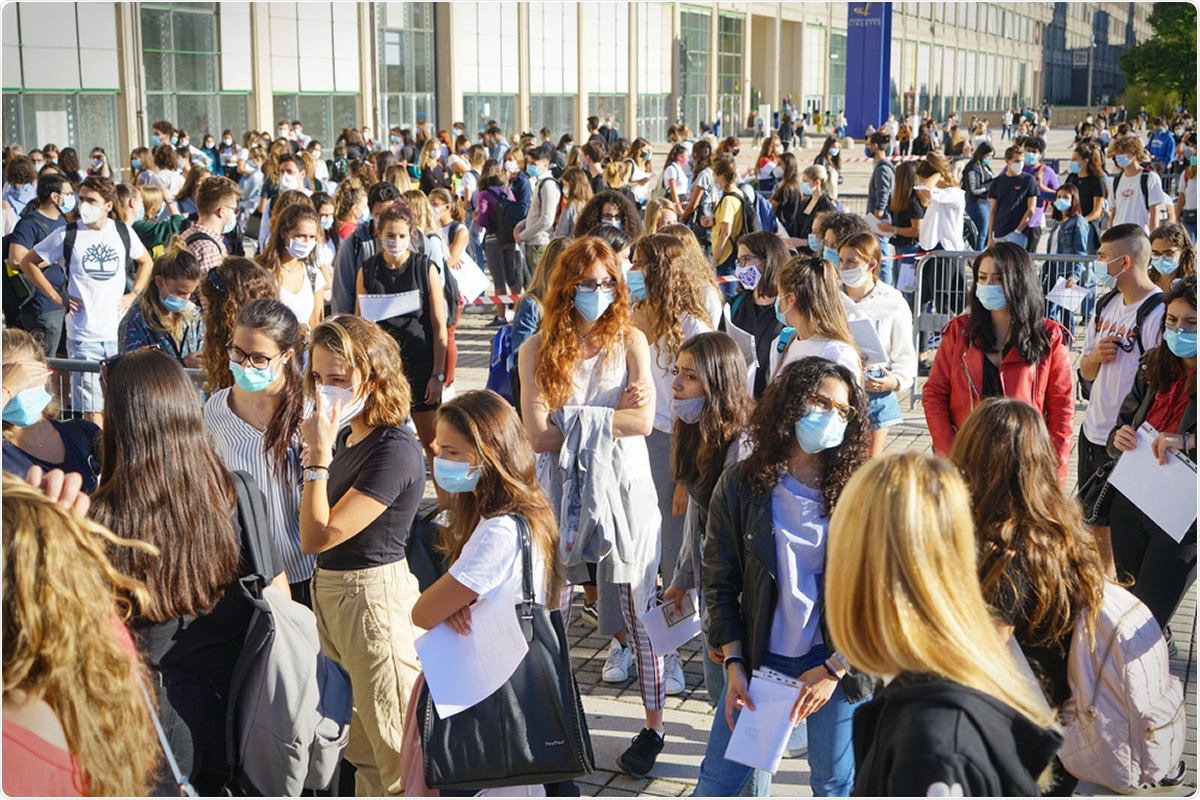A team of scientists from Italy has recently conducted a study to investigate the incidence of severe acute respiratory syndrome coronavirus 2 (SARS-CoV-2) infection among students attending Italian schools after reopening after COVID-19 lockdown. The findings reveal that the transmission of SARS-CoV-2 is low among younger students. The study is published on the medRxiv* preprint server.

Students queuing at the school entrance. Turin, Italy - September 2020. Image Credit: Mike Dotta / Shutterstock M By

 This news article was a review of a preliminary scientific report that had not undergone peer-review at the time of publication. Since its initial publication, the scientific report has now been peer reviewed and accepted for publication in a Scientific Journal. Links to the preliminary and peer-reviewed reports are available in the Sources section at the bottom of this article. View Sources
This news article was a review of a preliminary scientific report that had not undergone peer-review at the time of publication. Since its initial publication, the scientific report has now been peer reviewed and accepted for publication in a Scientific Journal. Links to the preliminary and peer-reviewed reports are available in the Sources section at the bottom of this article. View Sources
As a control measure to contain the outbreak of coronavirus disease 2019 (COVID-19), governments of more than 190 countries declared school closures at the initial period of the pandemic. As a result, about 91% of students became confined at home globally, leading to significant disruption in daily life activities, learning, and wellbeing of students.
Because of the strict implementation of control measures, European countries were able to control the COVID-19 outbreak early on. However, because of the severe impact of nationwide lockdown on the country’s economy, lifting of lockdown has been done by the majority of governments, with the compulsory implementation of masking, hand sanitizing, and physical distancing.
In Italy, the second wave of SARS-CoV-2 infection began in early September 2020, with more than 2,000 new cases per day and a sharp rise in hospital admissions and COVID-19-related mortality. Regarding school reopening during the second wave of the pandemic, it is vital to investigate the status of SARS-CoV-2 transmission among students and identify the susceptible student population.
In the current study, the scientists aimed at providing a preliminary report on the incidence of COVID-19 among students attending Italian schools. They also investigated whether there is any association between types of schools and the rate of infection.
Important observations
The scientists collected the data for analysis from a publicly available online dataset that daily monitor media news about the SARS-CoV-2 incidence among students attending Italian schools.
The data revealed a total of 1,350 COVID-19 cases in Italian territory schools as of 5 October 2020, including 1,059 students, 145 teachers, and 146 school staff. About 17%, 22%, 15%, 33%, and 4% of cases were found in nursery/kindergartens, elementary schools, middle schools, high schools, and peer institutions, respectively. Unlike peers’ schools, National schools reported only one incidence in more than 90% of COVID-19 cases. In addition, a cluster of more than 10 cases were reported in one high school.
The scientists found that about 14% of all schools were closed after detecting one or more COVID-19 cases. Specifically, about 21%, 12%, 11%, 10%, and 21% of nursery/kindergartens, elementary schools, middle schools, high schools, and peer institutions were closed after the identification of isolated SARS-CoV-2 infection among students.
Study significant
The current study findings suggest that with proper implementation of preventive measures, the transmission of SARS-CoV-2 within schools can be kept under control. The study also reveals that instead of implementing 14-day quarantine strategy for suspected or confirmed cases, many schools opt for complete closure. According to the scientists, a complete school closure, even with the detection of small numbers of cases, may have potential consequences on the wellbeing of children and their family members.
Regarding the involvement of children in SARS-CoV-2 transmission, a large number of studies have shown that children are less susceptible to SARS-CoV-2 infection than adults and that children and adolescents are less likely to transmit SARS-CoV-2 infection to adults. Given these observations, the scientists suggest that in the case of isolated (small cluster) COVID-19 cases, school closure may not be an effective strategy for controlling the viral spread.
However, the scientists think that the preliminary information they gathered in the study may not be proving the actual situation in schools, as the data were solely collected from media reports, and they did not formally verify the reliability of the data with individual schools.

 This news article was a review of a preliminary scientific report that had not undergone peer-review at the time of publication. Since its initial publication, the scientific report has now been peer reviewed and accepted for publication in a Scientific Journal. Links to the preliminary and peer-reviewed reports are available in the Sources section at the bottom of this article. View Sources
This news article was a review of a preliminary scientific report that had not undergone peer-review at the time of publication. Since its initial publication, the scientific report has now been peer reviewed and accepted for publication in a Scientific Journal. Links to the preliminary and peer-reviewed reports are available in the Sources section at the bottom of this article. View Sources
Article Revisions
- Mar 28 2023 - The preprint preliminary research paper that this article was based upon was accepted for publication in a peer-reviewed Scientific Journal. This article was edited accordingly to include a link to the final peer-reviewed paper, now shown in the sources section.